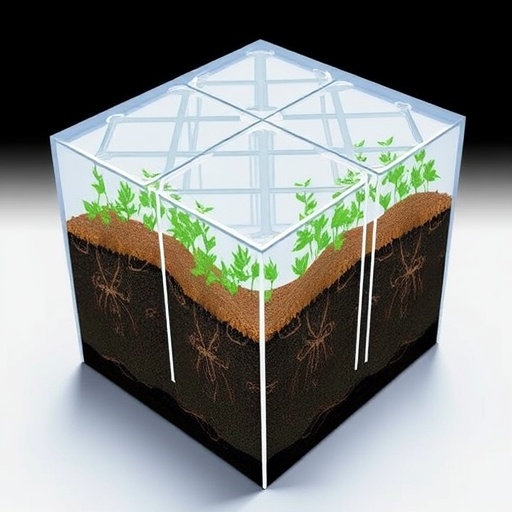In groundbreaking new research published in Nature, scientists have uncovered the intricate hormonal signaling pathways that govern how rice roots respond to soil compaction, a common agricultural stress that severely limits root growth and crop productivity. The study reveals a pivotal role played by ethylene in orchestrating changes in root cell wall mechanics through the regulation of OsARF1, a transcription factor responsible for modulating cellulose biosynthesis and cell wall thickness in root cortical cells.
Soil compaction poses a significant obstacle for plants, restricting oxygen diffusion and physically impeding root penetration. Overcoming this challenge is vital for securing food production as global soil degradation intensifies. The research team investigated how rice roots sense and adapt to dense, compacted soil environments. They identified ethylene as the primary gaseous hormone linking environmental stress induced by compaction to molecular changes within root cells.
Using rice lines carrying an OsARF1 promoter-driven GUS reporter, the researchers demonstrated that treatment with ACC, an ethylene precursor, resulted in a robust increase in OsARF1 expression, mirroring the response observed in roots grown in dense agar media designed to simulate compacted soil. This contrasted with treatments using auxin (IAA) and abscisic acid (ABA), which had minimal to modest effects on OsARF1 expression. These findings highlight ethylene’s dominant role in triggering transcriptional networks connected to root adaptation under mechanical stress.
Further analysis revealed that ABA had a nuanced influence, with moderate localized induction of OsARF1 in cortical regions but an overall reduction when measured across whole roots by quantitative PCR. This disparity suggests spatial complexity in hormone cross-talk, underscoring that ABA’s role may be context-dependent and possibly downstream of ethylene signaling. The interplay between these hormonal pathways invites deeper exploration into their integrated regulation during root stress responses.
Central to ethylene signaling are three key proteins: OsEIN2, OsEIL1, and OsEIL2, which act as an effector and transcription factors respectively. The study employed rice mutants lacking functional EIN2 or both EIL1 and EIL2 and observed how these genetic perturbations influenced OsARF1 and cellulose synthase gene (OsCESA) expression under dense media conditions. Fascinatingly, OsARF1 induction occurred in the eil1eil2 double mutants but was abolished in ein2 mutants, positioning OsARF1 downstream of OsEIN2 in the ethylene response pathway.
The cellulose synthase genes OsCESA5, OsCESA6, and OsCESA8 displayed complex, differential regulatory patterns dependent on the ethylene signaling components disrupting their normal downregulation during compaction stress. This suggests a highly sophisticated regulatory network controls cellulose biosynthesis in response to environmental cues, modulating cell wall remodeling essential for adapting root structure.
Physiologically, the absence of ethylene sensitivity in ein2 and eil1 seedlings resulted in thinner roots that paradoxically exhibited enhanced soil penetration ability. This contrasts with observations where roots overexpressing OsARF1 or mutants in cellulose biosynthesis exhibited thicker roots yet also demonstrated improved penetration. This apparent contradiction highlights the multifaceted nature of root-soil mechanical interactions and suggests multiple adaptive strategies may operate simultaneously.
To decipher these complexities, growth experiments incorporating the cellulose synthesis inhibitor indaziflam provided additional insight. Root thickening responses persisted in ethylene pathway mutants, implying that modifications in cellulose biosynthesis may be controlled through partially independent or convergent pathways downstream of OsEIN2, OsEIL1, and OsEIL2. These insights open new avenues to manipulate root architecture by targeting specific hormonal and transcriptional nodes.
Wall stiffness measurements of epidermal and cortical layers in the ethylene-mutant roots aligned with modeling predictions, supporting a framework where a thicker epidermis coupled with a thinner cortex optimizes root mechanical properties for soil penetration. Moreover, the ein2 mutants’ failure to swell in compacted conditions may stem from impaired ABA accumulation, linking hormonal dynamics to biomechanical outcomes.
Collectively, this research advances our understanding of the sophisticated molecular and cellular responses enabling rice roots to sense and adapt to mechanical impedance. By integrating hormone signaling pathways with precise modulation of cell wall mechanics, plants dynamically alter root architecture to negotiate compacted soils. This knowledge holds promise for engineering crops with enhanced resilience to challenging soil environments.
The study’s detailed elucidation of ethylene’s central role as a mediator in this process underscores the hormone’s versatility beyond traditional growth regulation, implicating it as a key environmental sensor that triggers adaptive developmental programs. Harnessing these insights could enable the design of cultivars optimized for suboptimal soils, potentially improving crop yield and sustainability worldwide.
Future investigations will be crucial to unravel the exact molecular interactions between ethylene, ABA, and auxin signaling in root cells under stress, and to clarify the distinct contributions of cellulose synthase isoforms in conferring mechanical properties. Such work is imperative for developing sophisticated biotechnological interventions aimed at mitigating agricultural losses due to soil compaction.
This pioneering research exemplifies the convergence of genetics, plant physiology, and biomechanical modeling to address pressing challenges in crop science. It paves the way for next-generation approaches to plant breeding that harmonize growth and environmental adaptability through targeted manipulation of hormonal and mechanical signaling networks within roots.
As climate change exacerbates soil degradation and intensifies compaction-related issues, unraveling the hormonal and mechanical frameworks controlling root-soil interactions becomes even more critical. The strategies uncovered here establish a foundational blueprint for engineering root systems capable of thriving in increasingly hostile underground environments.
Subject of Research:
Ethylene-mediated modulation of cell wall mechanics driving rice root responses to soil compaction.
Article Title:
Ethylene modulates cell wall mechanics for root responses to compaction.
Article References:
Zhang, J., Liu, Z., Farrar, E.J. et al. Ethylene modulates cell wall mechanics for root responses to compaction. Nature (2025). https://doi.org/10.1038/s41586-025-09765-7
Image Credits:
AI Generated
DOI:
https://doi.org/10.1038/s41586-025-09765-7
Keywords:
Ethylene signaling, OsARF1, rice root, soil compaction, cellulose synthase, cell wall mechanics, hormonal regulation, root architecture, abiotic stress response
Tags: adaptation to soil stress in agriculturecellulose biosynthesis in plantsethylene precursor ACC in plant developmentethylene signaling in rice rootshormonal regulation of cell wallsimpact of soil degradation on crop productivitymechanisms of root penetration in compacted soilsOsARF1 transcription factor functionovercoming agricultural challenges with root adaptationrice root response to environmental stressroot cell wall mechanicssoil compaction effects on root growth





